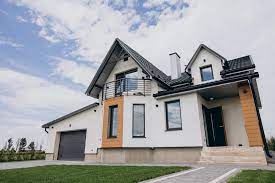Painting your home’s exterior not only gives it a new, updated appearance and improves curb appeal, but it also shields it from the elements. The outside of your house is always exposed to the elements—sun, rain, wind, and temperature changes—all of which can damage its surfaces. We’ll go over the fundamentals of exterior painting in this blog post and see how important it is to protecting your house from the weather.
The Significance of Painting Outside
Let’s first discuss why exterior painting is so important for your home’s longevity and protection before getting into the specifics:
- Weather Resistance: Paint applied outside acts as a barrier to keep out moisture, snow, and rain. It keeps moisture from seeping into the surfaces of your house, which can cause rot, mold, and structural damage.
- UV Protection: The siding and trim on your home can deteriorate, peel, and fade due to UV rays from the sun. High-quality exterior paint protects your surfaces from UV ray damage by having UV-resistant qualities.
- Avoiding Cracks and Peeling: When paint is applied correctly, it forms a strong, flexible surface that can flex and contract in response to temperature changes, which lessens the chance of cracks and peeling.
- Increased Durability: You can save money on expensive replacements by prolonging the life of your siding and trim with a well-maintained exterior paint job.
Now that we know how important exterior paint is, let’s examine the other necessities for weatherproofing your house:
- Surface Readiness
A good exterior paint job starts with proper surface preparation. This comprises:
- Cleaning: Clear the surfaces of any loose or flaking paint as well as debris, dust, and mildew. Pressure washing is frequently a useful technique.
- Repairing: Before painting, take care of any damage or flaws, such as rot, holes, or cracks. It’s crucial to replace, fill, and patch damaged wood.
- Priming: Use a premium primer to give the paint a uniformly smooth surface on which to cling. Additionally, primer encourages paint adhesion and helps ward off stains.
- Selecting the Appropriate Paint
Choosing the right exterior paint type is essential for long-lasting protection. Take into account these elements:
- Paint Type: Because of their flexibility and durability, latex (water-based) paints are frequently used outside. They are simple to clean and don’t crack easily. Oil-based paints, however, might be required for particular surfaces or climates.
- Finish: There are differences in sheen and durability between different paint finishes (such as gloss, satin, flat, or semi-gloss). Satin or semi-gloss finishes are frequently advised for exteriors due to their good moisture resistance and ease of cleaning.
- Color: Pick a hue that goes well with the surrounding landscape and architecture of your house. Remember that darker hues might absorb more heat, which could cause the surfaces to expand and contract.
- Appropriate Use
The efficacy of exterior paint can be greatly affected by how it is applied. The following application advice is provided:
Use High-Quality Tools: For a professional finish, spend money on brushes, rollers, and spray equipment of the highest caliber.
Temperature Considerations: To determine the best temperature range for painting, refer to the manufacturer’s recommendations. Paint adherence and drying can be impacted by extreme heat or cold.
Several Coats: To guarantee complete coverage and protection, apply a minimum of two coats of paint.
Whether applying by brushing, rolling, or spraying, be consistent in your technique to prevent streaks and irregularities in the final product. For expert advice and assistance in achieving a flawless paint finish, consider reaching out to DuVall Painting and Repairs.
- Consistent Maintenance
Even the best external paint job needs regular upkeep to extend its life and improve its protective properties:
- Examine Every Year: Ensure that the outside of your house is free of wear and tear. Deal with any problems as soon as possible to stop more harm.
- Cleaning: To get rid of mildew, pollen, and dirt, give your home’s exterior a regular wash. Painting surfaces can be effectively cleaned with pressure washing.
- Touch-Ups: Save any leftover paint for touch-ups down the road, particularly in exposed or high-traffic areas.
- Repaint When Necessary: Depending on the quality and climate, exterior paint can last anywhere from five to ten years. It’s time for a new coat when you see fading or deterioration.
- Weather-Related Issues
The success of your exterior paint project depends on when you schedule it. This is how the weather enters the equation:
Avoid Extreme Weather: Schedule your project for a time when the weather is moderate. It is best to avoid painting in extremely hot or cold weather as these conditions can interfere with paint adhesion and drying times.
Dry Surfaces: Prior to beginning the painting process, make sure the surfaces are dry and free of moisture. Painting over wet surfaces can cause paint failure and adhesion issues.
Overcast Days: Because they offer a steady temperature and lessen the chance of the paint drying too quickly, overcast or partly cloudy days are frequently perfect for painting the outside.
In Summary
Painting a home’s exterior is important for protection and upkeep, not just for looks. You can protect your house from the weather and increase its lifespan by carefully priming surfaces, selecting paint, and applying it. Your home will stay lovely and well-protected for many years to come with routine upkeep and prompt repainting services when needed. Never undervalue the importance of a brand-new exterior paint job in maintaining the beauty and structural integrity of your house.



